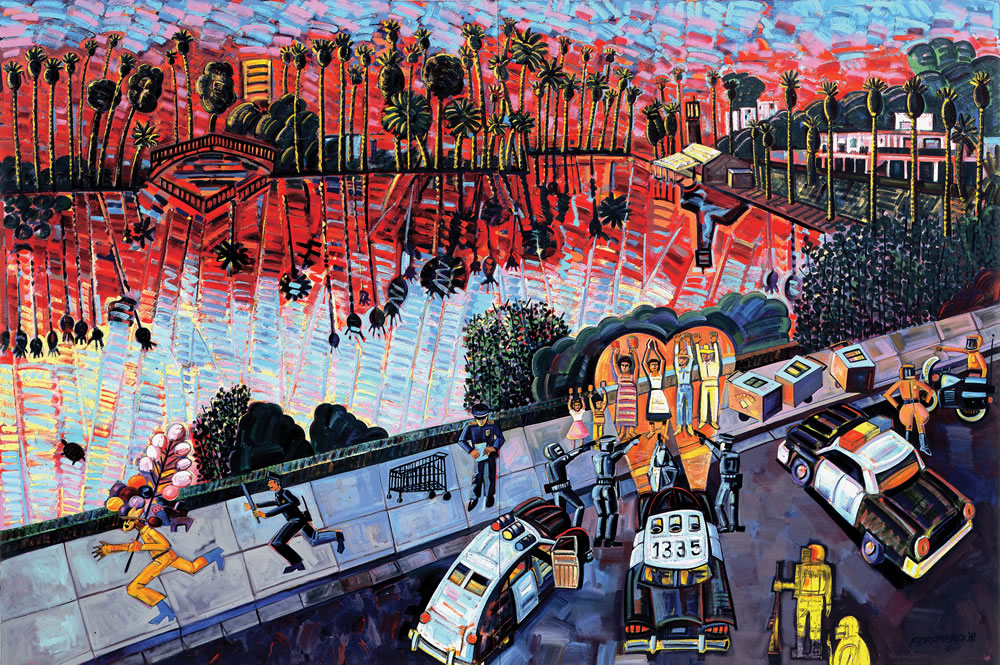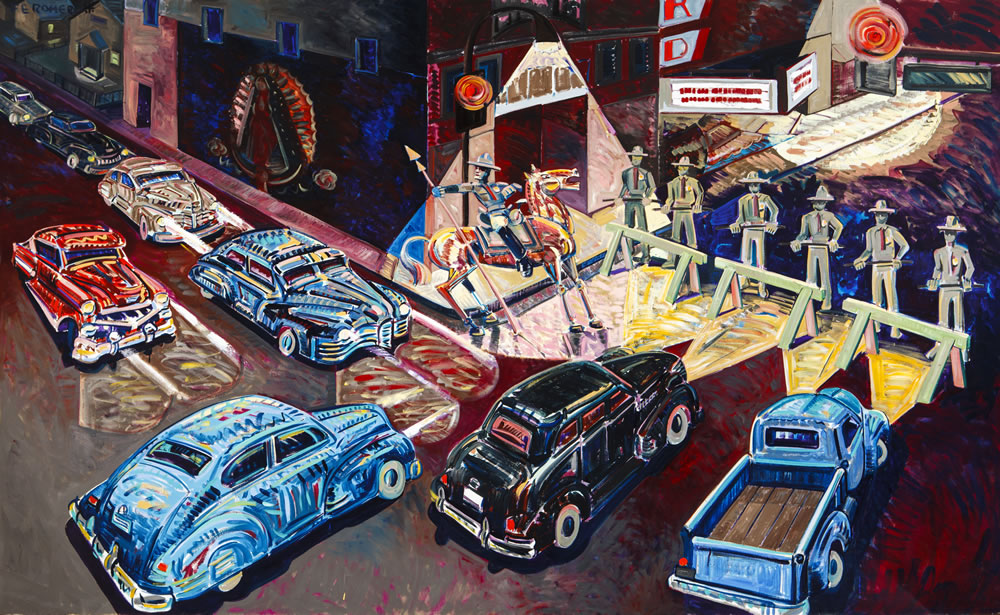Dreamland: A Frank Romero Retrospective at MOLAA
Words by Katrina Mohn, Arts Writer, Bermudez Projects
Throughout the retrospective, which spans 50 years of Romero’s creative output, almost every type of media is on display. Several walls are hung with “movable murals” – gallery-length paintings two or three panels across. A vitrine holds glazed ceramic plates and small wooden sculptures. A darkened room shows a video of Romero and his Los Four comrades but also provides a dim space to highlight two pieces rendered in neon. Even with the wide array of this massive show, one gets the impression of barely scratching the surface of a hyper-prolific man’s legacy.
Furthermore, one notices an obsession with certain icons. Dogs, horses, palm trees, highways, police officers all appear in shifting settings renderings and scenarios. Floating above the rest is the most Los Angeles of all Los Angeles icons: the car.
Those painted, sculpted or sketched curves make the vehicle sexy and cartoonish in turns. Certainly, the cars’ fenders and oversized wheels cite Chicano car culture and the vehicles of the 1950s – but every single car in every single painting is given the same treatment. It glides through his paintings, up highways and into mountains. It witnesses scenes of police brutality or marches on streets alongside protestors. It joins processions toward the new Los Angeles Coliseum for the 1984 Olympics. Sometimes truck, sometimes sedan, appearing in all manner of colors, the car represents both a distilled character of the city and as Romero himself, sunk deep into the culture of Los Angeles bearing witness to its triumphs and sorrows.
The love of home and city is overwhelming. But it is not an uncomplicated love – many of the pieces depict ugly moments in LA history. An entire gallery is dedicated to police brutality and corruption. Not just brutality and the LAPD in general – specific incidents are depicted in works such as The Death of Rubén Salazar (1986) and The Arrest of the Paleteros (1996). These events repeat themselves in murals and vignettes with the same regularity as palm trees, dogs and cars.
It is uncertain how someone outside of Los Angeles would understand these paintings. Would they recognize the icons of the city – Los Angeles Central Library, the tunnel into the San Gabriel Hills from the 5 Freeway? It is unlikely the experience of these murals would be so profound without personal relationships with the buildings looming before the mountains. Romero doesn’t shy away from the specific – locations of landmarks, named individuals, historic events. A universal experience is not the point.
As historically specific as the issues are, viewing the work in February 2017 yanks the viewer into contemporary, very contemporary issues. There are more than just shades of the current political climate in the images of the National Chicano Moratorium Committee moratorium of 1970 and the images of LAPD cuffing and dragging off people en masse.
Unlike most exhibitions, which leave the viewer a little gallery-fatigued, Romero’s work begs a second or even third walkthrough. The visual language of Romero’s Los Angeles – the vibrant landscapes and swooping highways, the repetition of scenes and characters – needs time to settle in.
Once settled in, the show is thrilling like riding a fantastically-clear Los Angeles highway.
Dreamland: A Frank Romero Retrospective runs through May 21, 2017. Visit www.molaa.org for more information.
Frank Romero
The Arrest of the Paleteros
1996
Oil on canvas
Courtesy of the Cheech Marin Collection
Frank Romero
The Closing of Whittier Blvd.
1984
Oil on canvas
Courtesy of The AltaMed Art Collection




